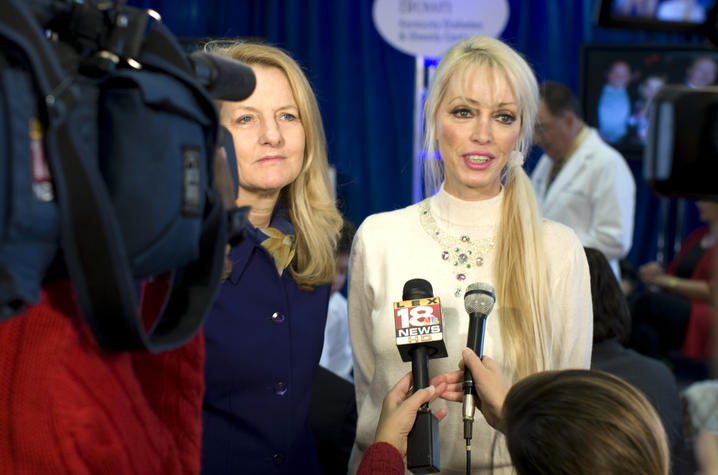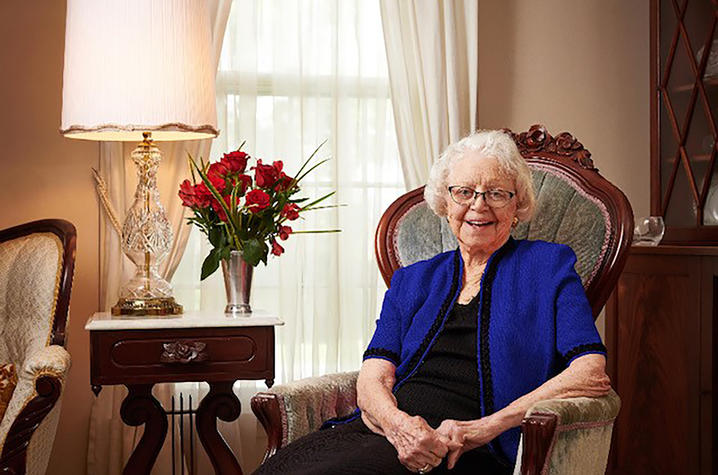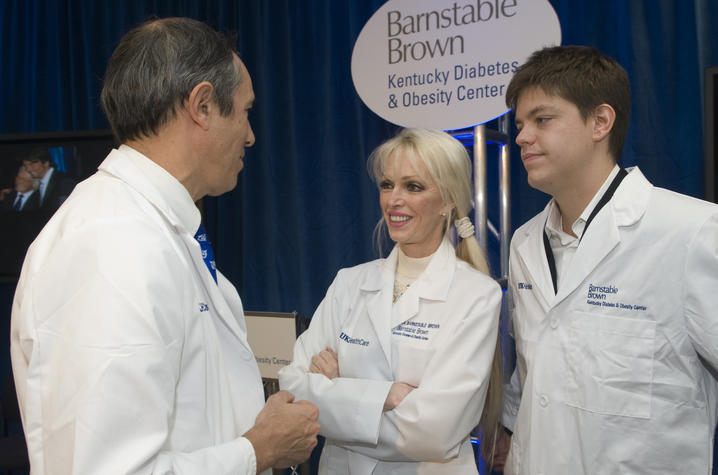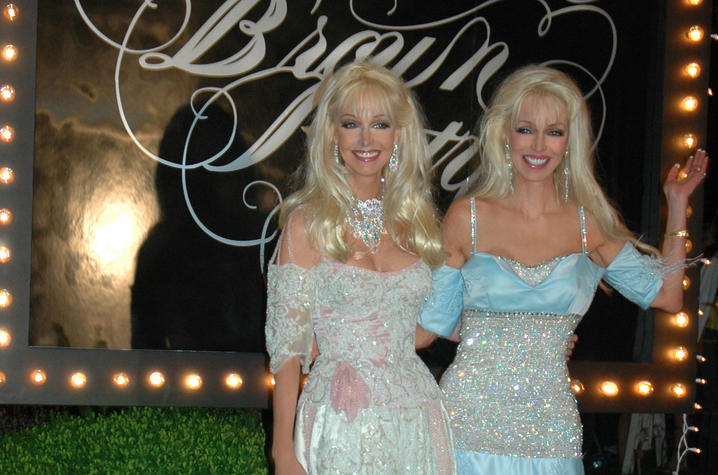Win, place and show out: The Barnstable-Brown legacy at UK
LEXINGTON, Ky. (Aug. 18, 2023) — In the hours before his chestnut colt, Aristides, galloped to victory at the inaugural Kentucky Derby, thoroughbred owner and notorious gambler Henry Price McGrath was already celebrating. While luxuriating beneath a dense grove of locust trees on his Lexington stud farm known as McGrathiana — now home to the University of Kentucky’s Coldstream Research Campus — McGrath and fellow silk hat-wearing gentry gorged on a feast of burgoo, mutton, and bourbon. Lots of bourbon.
This lavish tradition continues a century-and-a-half later throughout the Commonwealth as a ritual known as the Derby Eve Party.
Some Derby eve festivities are sedate, dignified affairs; others can generously be characterized as “raucous” or “hedonistic.” Most fall somewhere in the middle. Regardless of the size, menu or guest list, these bacchanals all pay tribute to the Sport of Kings. Only one event, however, can lay claim to the highest order of both festivity and charity: the annual Barnstable-Brown Derby Eve Gala.
The Barnstable-Brown Gala emerged out of necessity when Derby-themed parties were de rigueur for the Kentucky social elite. Despite Louisville’s storied Churchill Downs racetrack being the site of the Run for the Roses since the beginning in 1875, most Derby gaiety was concentrated 80 miles to the east in Lexington. Former Wrigley’s Doublemint Gum spokesmodels Patricia “Tricia” Barnstable-Brown and Priscilla “Cyb” Barnstable — along with their mother, Wilma “Willie” Barnstable — took it upon themselves to fill a merrymaking void for Louisvillian society closer to home.
Tricia and her husband, physician and educator David E. Brown, first opened their tony mansion overlooking Spring Drive to a few hundred celebrants in 1989. Leveraging contacts from the twins’ years working in Hollywood, the black-tie gala started to draw a veritable “who’s who” of sports and entertainment to their nascent parties.
“It was astonishing that there really weren’t any celebrations at that time in Louisville,” Tricia says. “We started with about 500 people. We invited James Garner. Dixie Carter. Lots of stars. And they came!”
Influential industrialists brushed elbows with glamorous supermodels. Motown divas danced into the wee hours next to gridiron Goliaths. It soon became the proverbial hottest ticket in town. The New York Times dubbed it “the granddaddy of all Derby parties.”
“Now, the party has more than doubled in size,” Tricia continues.
Throngs of shiny limousines and stylish SUVs slowly snake their way through Louisville’s Highlands neighborhood to deliver the occupants within. Paparazzi flashbulbs and a cacophony of spectator screams announce the arrival of the latest pop culture sensations like Jack Harlow or Morgan Wallen. Media outlets from around the globe report on the comings and goings. Christened by Condé Nast as one of the 10 best parties in the world, the event has grown beyond the Barnstable-Browns’ wildest expectations.
“It’s almost unimaginable,” Tricia sighs incredulously. “The thing that most people may not realize is that it was a fundraiser for diabetes from the very beginning because diabetes runs through David’s side of the family.”
As his wife, sister-in-law and mother-in-law bore much of the heavy lifting in terms of the party planning duties, David’s favored role was to ensure everyone felt welcome.
“That was important to him,” Tricia recalls of her husband, a former United States Army captain. “He greeted and thanked each person for attending and for their support. Every. Single. One.”
Despite bouts of debilitating illness, he gladly filled this position until his death from diabetes complications in 2003, aged 68. In the wake of the tragedy, the family decided to add even greater purpose to their annual soiree by using it to help fund a diabetes and endocrinology research center at the University of Kentucky.
Since its establishment in 2008 with a gift in David’s memory, the UK Barnstable Brown Diabetes Center has become a recognized leader in diabetes research, treatment, prevention and education. The annual gala has generated more than $17 million for the center over the past 15 years.
“Credit goes to my mother. She was instrumental in the idea of donating to the University of Kentucky,” Tricia explains. “She made up her mind that she wanted to be involved in UK HealthCare.”
The decision to root a center at UK seemed an obvious fit. After all, the family is composed of generations of Wildcats. The parents met at UK in the late 1940s. Born and raised in Illinois, Dale Barnstable was a star athlete who helped lead the UK men’s basketball team to their first two NCAA national championships. Willie Haverly, a native of Corbin, Kentucky, was an academically gifted teenager who dreamed of being a teacher. At 16, Willie hopped a train to Lexington and enrolled at UK to study history.
“My father played for Adolph Rupp,” Barbara Barnstable Edelman explains. “When my mother met my father, that’s when she became a total Wildcat sports fan — lifelong.”
All four of the couple’s children — Tricia, Cyb, Barbara and Dale Jr. — graduated from UK. The twins were on the cheerleading squad. Dale Jr. was a basketball walk-on under Joe B. Hall. Barbara’s future husband, Ray, was a scholarship player under legendary coaches Rupp and Hall between 1970 and 1974.
“I’ve always laughed that I’m the only one who didn’t do anything athletically, so I just became a super fan,” Barbara says.
Barbara confirms having the Barnstable Brown Diabetes Center at their alma mater is a source of pride for the family because it serves the broader Kentucky community that has been heavily impacted by diabetes.
“This is a place that we love — our family loves this university,” she explains. “It’s deeply, deeply ingrained in all of us. It’s hugely significant that the center is here in Lexington and that it’s at UK. The university gave a lot to us, and this is a way of giving back. I’m always championing how important it is to stay focused on fundraising for UK.”
Barbara describes the center as a symbol of the family’s priorities.
“It’s easy for people to give their money to the athletics department, and you’ll not find bigger fans of UK basketball and football than our family — I mean, we’re huge fans of all the athletic endeavors — but diabetes is real and it’s not glamorous,” she says. “It’s such a problem, so it’s very meaningful that the Barnstable legacy is trying to do something about a problem, not just talking about it. And it really is a standing tribute to my sister and certainly my mother.”
Among the matriarch’s defining attributes was a razor-sharp mix of intellect and creativity, according to Barbara. This combination helped turn the gala into such a rousing success and inspired those around her.
“She knew how to get things done,” Barbara says. “She had a solid work ethic and high expectations for herself and everybody around her — especially her children.”
“Nobody got off easy,” she laughs.
“Willie was amazing,” says Lisa Tannock, M.D., UK College of Medicine vice dean for faculty affairs and development, Schwartz Commonwealth Professor for Physician Leadership and professor of internal medicine at UK. “She was this tiny ball of energy. She was truly committed and a tremendous organizing force behind the gala. Obviously, the rest of the family is critically involved, but she had the vision. She was just down to earth with the most amazing people skills at all levels.”
While the annual gala provides a glitzy opportunity for the worlds of equine racing, celebrity, fashion and high society to align in a prelude to the “most exciting two minutes in sports,” the Barnstables still are ever mindful of their initial and ongoing goal: funding diabetes research and care.
“Mother and Tricia were very interested in how the money would be spent and what it was going toward — whether it would be going to what they wanted to be done with it, which was research,” Barbara recalls. “They didn’t want it to just go to administrative costs, overhead and the like. It had to be for something very quantifiable with a real purpose. Mother was involved in every aspect of the vision and how they wanted the proceeds to be used.”
Charles “Chipper” Griffith, M.D., acting dean of the UK College of Medicine, says the center’s importance should never go unrecognized.
“The support from the Barnstable-Brown family has catalyzed our ability to provide more coordinated clinical care for patients,” Griffith explains. “It’s catalyzed the research and educational aspects. It’s brought together a cadre of investigators — from the Department of Pharmacology and Nutritional Sciences, from Internal Medicine, from Endocrinology, from Pediatrics to any number of other departments — to do cutting-edge research into diabetes. The synergy is where the center’s power comes from — that’s its power and strength.”
At the UK Barnstable Brown Diabetes Center, the only facility of its type in Kentucky, researchers are working on ways to fight and understand the complications that arise with the disease.
“Much of our research at UK involves why patients develop certain complications from diabetes,” Tannock elaborates. “Dr. Simon Fisher is looking at hypoglycemia and low blood sugar risks. Dr. Philip Kern is investigating metabolic syndrome and associated vascular risk. My area deals with why people with diabetes have heart attacks and strokes. There’s a number of us who look in those areas. It’s not just the fact that they have diabetes and their blood sugar is high; it’s also the other ways diabetes impacts their lives, and we’re trying to figure out why and develop new treatments to help prevent it and save lives.”
The diabetes rate in the United States is staggering. The Centers for Disease Control and Prevention estimates that more than 130 million adults in the U.S. are living with diabetes or prediabetes. In Kentucky, diabetes rates are disproportionally higher than in most other states. More than 12 percent of all adults in the Commonwealth have diabetes. Worse, rates are significantly higher in areas such as Eastern Kentucky, where the population tends to be less affluent and less educated. However, efforts to combat these dire statistics are underway thanks to the UK Barnstable Brown Diabetes Center.
“We’re improving the quality of care we provide people here in Lexington, and we’re continuing to expand our clinical footprint throughout Kentucky,” says Simon Fisher, M.D., Ph.D., the newly appointed center director. “We have outreach clinics where we send providers to Eastern Kentucky, where parents may have difficulty accessing proper care for kids with diabetes. The pediatric group is going to clinics in rural Kentucky to build and improve their care.”
According to Fisher, the center has doubled the number of patients receiving treatment over a half-decade. Each year, clinicians manage and treat Type 1 and Type 2 diabetes, prediabetes, gestational diabetes and other diabetes- and obesity-related diseases of thousands of area patients.
“Many of the impoverished areas of Kentucky, in particular, are food deserts, health care deserts, diabetes education deserts, among other things, so the expansion of telehealth services and the increased collaboration with local facilities to ensure that the patients can get the care they need as close to home as possible has been a major goal,” Tannock adds.
“It’s lifesaving for many people,” Barbara says of the center dedicated to her brother-in-law. “We all just get to pass through this life once, and if you have the opportunity to do something meaningful for other people, then that’s what you hope to do and that’s what my mother hoped to do as well.”
Willie Barnstable died in October 2022, aged 94. And while the gala maintains momentum with the next generation of Barnstables assuming leadership roles — Christopher Barnstable-Brown, an esteemed New York attorney and the only child of David and Tricia, along with his wife, Sarah, now attends to many public relations, guest relations and corporate sponsorship functions — an integral part of the festivities is deeply missed.
“My mother and I were a good team,” Tricia says, her voice faltering for a split second and then recovering. “She taught us to always be real, legitimate, honest and caring — and that’s what we try to do.”
Barbara says her favorite party recollections revolve around her mother’s almost-encyclopedic knowledge of the guests.
“My fondest memories are always just enjoying the night with my mother. She was just the queen bee, the queen of the crowd. We always sat in a certain spot. She knew the guests. She sold tickets to them. She developed friendships with them. She personally knew half of the people attending. She was just remarkable — there she was, 93 years old, just sitting there, and along comes Kid Rock to give her a big kiss. For me, the fun was watching her have a blast.”
The Kentucky Derby celebrates its sesquicentennial on May 4, 2024. The historic 150th run is certain to garner more attention than usual and bolster events associated with it. Inquiries regarding the 2024 Barnstable-Brown Derby Eve Gala — the event’s 35th year — arrived even before the champagne flutes from this year’s party were shelved.
“It started the night of the party!” Tricia laughs. “I’m already getting multiple emails a day. Interest is greater now than ever before.”
Tricia describes the fundraiser as a passion project and shows no signs of slowing down despite being at it for more than three decades. Her devotion to the cause and the attendees who support it mitigate any stress generated by trying to outdo the previous party.
“I get energy from the guests,” she says. “There are wonderful and generous people in the world and the party is really a credit to all those who show up year after year for such an important cause.”
This story first appeared in the Summer 2023 issue of the Kentucky Alumni Magazine.
UK HealthCare is the hospitals and clinics of the University of Kentucky. But it is so much more. It is more than 10,000 dedicated health care professionals committed to providing advanced subspecialty care for the most critically injured and ill patients from the Commonwealth and beyond. It also is the home of the state’s only National Cancer Institute (NCI)-designated Comprehensive Cancer Center, a Level IV Neonatal Intensive Care Unit that cares for the tiniest and sickest newborns and the region’s only Level 1 trauma center.
As an academic research institution, we are continuously pursuing the next generation of cures, treatments, protocols and policies. Our discoveries have the potential to change what’s medically possible within our lifetimes. Our educators and thought leaders are transforming the health care landscape as our six health professions colleges teach the next generation of doctors, nurses, pharmacists and other health care professionals, spreading the highest standards of care. UK HealthCare is the power of advanced medicine committed to creating a healthier Kentucky, now and for generations to come.









